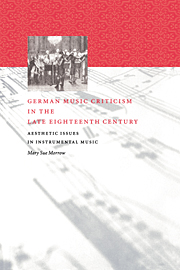Book contents
- Frontmatter
- Contents
- Acknowledgments
- Author's note
- Introduction: terms of discourse
- 1 What does instrumental music mean?
- 2 Answering with a unified voice
- 3 Answering with a German voice
- 4 Answering with aesthetic criteria
- 5 The importance of being correct
- 6 The reign of genius
- 7 A call to order
- 8 Epilogue: segue to the nineteenth century
- Notes
- Bibliography
- Index
1 - What does instrumental music mean?
Published online by Cambridge University Press: 03 October 2009
- Frontmatter
- Contents
- Acknowledgments
- Author's note
- Introduction: terms of discourse
- 1 What does instrumental music mean?
- 2 Answering with a unified voice
- 3 Answering with a German voice
- 4 Answering with aesthetic criteria
- 5 The importance of being correct
- 6 The reign of genius
- 7 A call to order
- 8 Epilogue: segue to the nineteenth century
- Notes
- Bibliography
- Index
Summary
[1773] All symphonies, all concertos, quartets, sonatas, and solos always leave us to wander around in undefined emotions of happiness and sadness; and when a piece is over, you can still ask, as did the famous Fontenelle: “Sonate, que me veux tu?”
[1786] Instead, there is a clarinet solo with bassoons, which in and of itself isn't bad; but the way it appears here, you cannot help but ask: “que me veux tu?”
[1792] The remaining five sonatas are worth about the same, that is, they can pass as divertimentos, etc. But if they are considered as sonatas, then the famous question would be appropriate: “Sonate, que veux tu de moi?”
“Sonate, que me veux tu?” “Sonata, what do you want of me?” This plaintive query, attributed to Bernard le Bovier de Fontenelle in the early eighteenth century, rapidly took on a life of its own, appearing again and again as the eighteenth century grappled with the problem of defining the aesthetic significance and exact meaning of instrumental music. That it took so long for someone to respond, “Why should it have to mean anything?” reflects the fact that the fledgling discipline of aesthetics lay firmly in the grip of the theory of mimesis. Mimesis was a concept resurrected from classical Greek philosophy, most notably from Aristotle's Poetics; in its simplest formulation it held that art should imitate nature. Its resurrection in the eighteenth century was tied to the attempt to raise the arts to a level worthy of philosophical contemplation, to accord them a more exalted place than they could ever have had as mere crafts.
- Type
- Chapter
- Information
- German Music Criticism in the Late Eighteenth CenturyAesthetic Issues in Instrumental Music, pp. 4 - 18Publisher: Cambridge University PressPrint publication year: 1997
- 1
- Cited by



